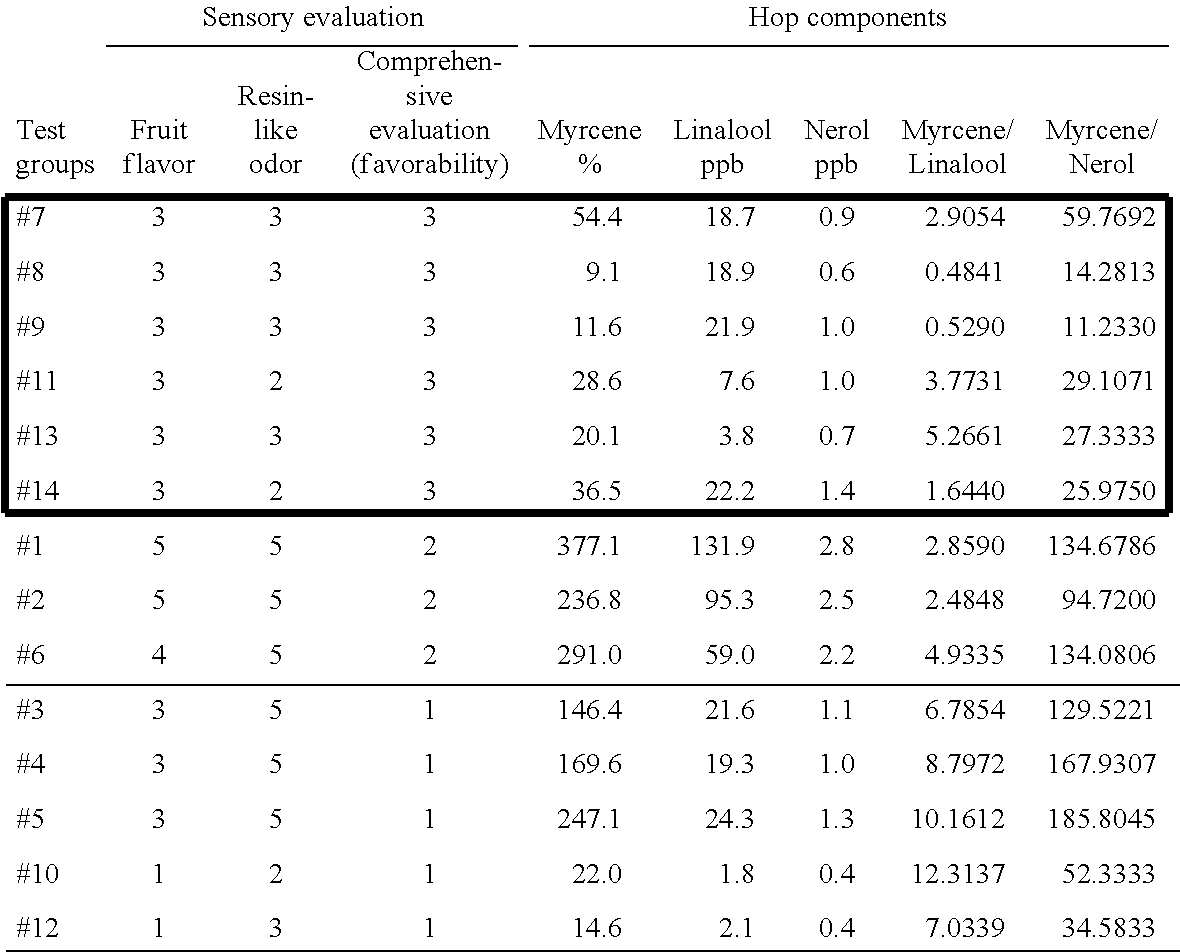Method for producing alcohol-free beer-taste sparkling beverage having fruity aroma imparted thereto with reduced off flavor
a sparkling beverage and fruity aroma technology, applied in beer brewing, biochemistry apparatus and processes, food science, etc., can solve the problem of not being able to feel a fruity aroma of the beverage, and achieve the effect of reducing off flavor and off flavor
- Summary
- Abstract
- Description
- Claims
- Application Information
AI Technical Summary
Benefits of technology
Problems solved by technology
Method used
Image
Examples
example 1
Experiment in Relation to the First Present Invention
[0072][Relationship Between Storage and Aging of Hops and Hop Essential Oil Components]
[0073]Before relationship between storage and aging of hops and the aroma of an alcohol-free beer-taste sparkling beverage was examined, relationship between storage and aging of hops and hop essential oil components was examined. Sealed Motueka hops produced in New Zealand were opened, and the hops were stored being in contact with air at the temperature (° C.) for the period (days) in Table 2 described below to perform storage and aging of the hops. Depending on the temperature (° C.) and period (days) of the storage and aging, eight test groups (test groups A to H) of the hops were provided. It should be noted that test group A is a test group using hops immediately before storage and aging.
[0074]Preparation of hop samples was made in a method as follows. 1 g of hop pieces was taken from the hop of each test group after storage and aging, and...
example 2
Confirmation of the Aroma Characteristics of Stored and Aged Hops and Validation Thereof from Chemical Components
[0081]In order to confirm the aroma characteristics of an alcohol-free beer-taste beverage using stored and aged hops from sensory and chemical component aspects, tasting samples were prepared using the stored and aged hops in Example 1, and sensory evaluation and chemical analysis were performed on the tasting samples.
[0082](1) Preparation of Tasting Samples
[0083]Tasting samples were prepared using a 1.5 L scale apparatus. First, a feed wort with a sugar content of the feed wort adjusted to 1.0 degree (the ratio of malt used at feeding 67%, the ratio of adjuncts used (rice, corn grits, and corn starch) 33%) was provided as a sample wort. This sample wort was heated and boiled with an electronic heater. At this time, boiling was controlled such that the boiling intensity was constant and that the evaporation ratio reached 10% in 60 minutes. When boiling of the sample wort...
example 3
Experiment in Relation to the Second Present Invention
[0094][Choice of Hop Variety]
[0095]To choose a suitable hop variety for imparting a fruity aroma, preparation and sensory evaluation of tasting samples were performed. Tasting samples were prepared using a 1.5 L scale apparatus. First, a feed wort with a sugar content of the feed wort adjusted to 13.5 degree (the ratio of malt used at feeding 67%, the ratio of adjuncts used (rice, corn grits, and corn starch) 33%) was provided as a sample wort. This sample wort was heated and boiled with an electronic heater. At this time, boiling was controlled such that the boiling intensity is constant and that the evaporation ratio reached 10% in 60 minutes. A hop was added at 0.5 g / L, 5 minutes before boiling of the sample wort was finished. After boiling was finished, an amount of water equivalent to the amount evaporated was added to the sample wort, which was left to stand at 95° C. for 60 minutes. Samples after filtration with a filter w...
PUM
 Login to View More
Login to View More Abstract
Description
Claims
Application Information
 Login to View More
Login to View More - R&D
- Intellectual Property
- Life Sciences
- Materials
- Tech Scout
- Unparalleled Data Quality
- Higher Quality Content
- 60% Fewer Hallucinations
Browse by: Latest US Patents, China's latest patents, Technical Efficacy Thesaurus, Application Domain, Technology Topic, Popular Technical Reports.
© 2025 PatSnap. All rights reserved.Legal|Privacy policy|Modern Slavery Act Transparency Statement|Sitemap|About US| Contact US: help@patsnap.com


